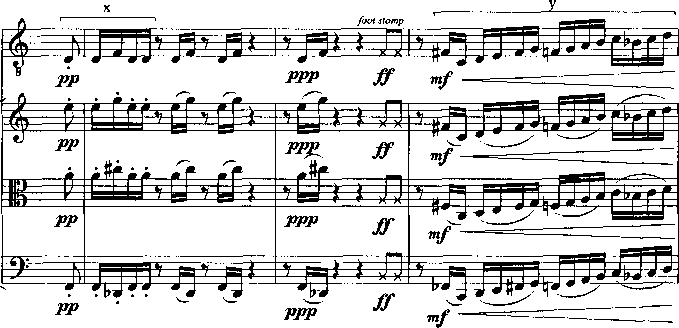44
following twenty measures have no direct quotes from the source material, only
occasional dotted rhythms or fragments from Joe Férail. Instead, the bulk of this section
is made up of material from the first response (mm. 2-6). This includes motive x, the five
note rising third pattern first used in m. 4, and a new motive of overlapping chromatic
scales, motive y, both shown in Example 1.17. Motive x is built on a five-note sixteenth
note sequence of stacked major and minor thirds, and becomes the most important motive
in the movement.
Example 1.17: Cajun Set, Third mvt., mm. 26-28

Each of the chamber works in this study contain motives built of major and minor
thirds which are a major hallmark of Larsen’s style. She first became fascinated with the
interval when she was assigned by Paul Fetler in graduate school to write a one hundred-
page paper on the history of the third.73 For her study, she looked at various tuning
systems from around the world and came to the conclusion that “a culture defines itself in
Larsen relates from this experience: “I learned a lot, galaxies of knowledge,
sociological, political, and all kinds of things about the third, and from then on the third
has had a lot of meaning to me.” (Bezerra, 22).
More intriguing information
1. The name is absent2. Migration and Technological Change in Rural Households: Complements or Substitutes?
3. Developmental Robots - A New Paradigm
4. Natural hazard mitigation in Southern California
5. Proceedings of the Fourth International Workshop on Epigenetic Robotics
6. The name is absent
7. Applications of Evolutionary Economic Geography
8. The name is absent
9. Global Excess Liquidity and House Prices - A VAR Analysis for OECD Countries
10. The fundamental determinants of financial integration in the European Union